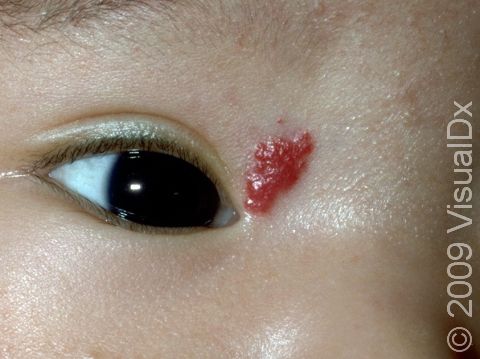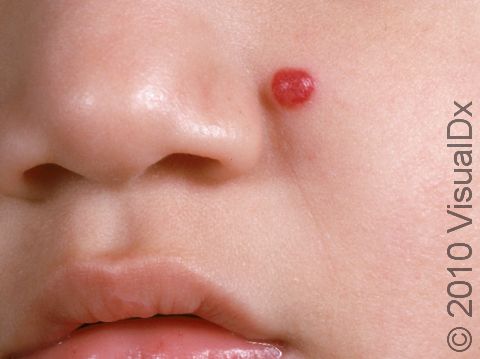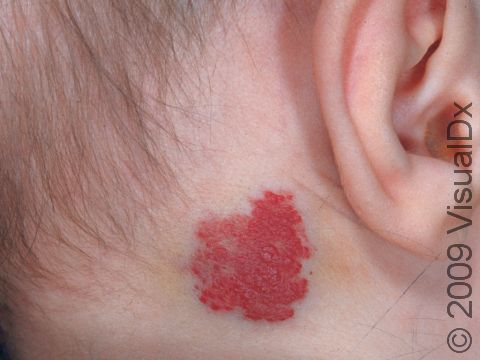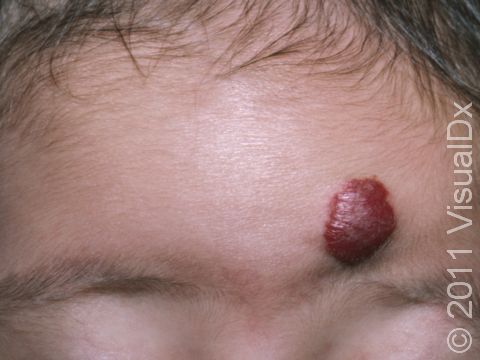Strawberry Hemangioma (Infantile Hemangioma)
Hemangiomas are harmless growths that are the result of rapidly dividing cells of the blood vessel walls known as endothelial cells. They appear shortly after birth and grow rapidly during the first year of life. They usually resolve on their own over the next few years. Hemangiomas can be many different colors, depending on where they are located. Superficial hemangiomas (also known as strawberry hemangiomas, due to their red color) are located in the top layer of skin. Those in the deeper layer of skin are called deep (cavernous) hemangiomas, and they can be blue or colorless. Most hemangiomas are limited to the skin. Children with multiple hemangiomas may have associated internal lesions involving the liver, lungs, or other internal organs. These are more serious in nature and are usually followed more closely by your child’s pediatrician.
Who's At Risk?
Hemangiomas affect about 10% of infants, and the risk is about 5 times higher in females than males. White infants and premature infants are at an increased risk for hemangiomas, as are infants born to mothers with an abnormal placenta. The risk is also raised in infants of women who had chorionic villus sampling during their prenatal period.
Signs & Symptoms
Most hemangiomas of infancy appear within the first 2 weeks of life. They may begin as a bump on the skin or as a flat, reddish patch that may appear similar to a bruise. Hemangiomas grow very rapidly for weeks or months, usually peaking in size at 6–9 months, and form raised areas ranging in size from a few millimeters to centimeters. They are bright red with well-defined borders. If a hemangioma grows very large, it may be prone to bleeding spontaneously.
Self-Care Guidelines
Typically, there are no self-care measures for hemangiomas, as they usually resolve without any treatment. It is important to note, though, that it can take several years for this to occur, and the color may not fade completely. Close observation for changes in the appearance is all that is needed. If the hemangioma does bleed, treatment with wet compresses and antibacterial ointment is usually sufficient. Bleeding hemangiomas need to be watched closely for infection.
Treatments
Most hemangiomas do not require any treatment. However, for those that are located in the child’s airway or those that threaten eyesight, treatment is necessary to slow down the growth. Your infant’s doctor may prescribe an oral corticosteroid. About 30% of hemangiomas will respond to the steroid and cause the growth of the hemangioma to slow down significantly, but it will not make it go away. For those hemangiomas that do not respond to an oral corticosteroid, the physician may prescribe another medication called interferon. This drug has a response rate of up to 70% but can also have adverse side effects. In the case of a severe hemangioma that does not respond to any medical therapy, radiation or surgical removal may be necessary. If you are worried about cosmetic appearance of the color later in your child’s life, he/she may be able to have laser therapy to help fade the color.
Visit Urgency
Seek medical care if your infant’s hemangioma changes in color, starts to bleed, appears infected, or appears to be blocking his or her vision, breathing, or feeding. Hemangiomas that are located in the diaper area or on the lower lip are particularly prone to bleeding, due to friction.
Trusted Links
References
Behrman RE, Kliegman R, Jensen HB, eds. Nelson Textbook of Pediatrics. 18th ed. Philadelphia, PA: WB Saunders; 2007.
Habif, TP. Clinical Dermatology: A Color Guide to Diagnosis and Therapy. 4th ed. New York, NY: Mosby Inc; 2004.
Paller AS, Mancini AJ. Hurwitz Clinical Pediatric Dermatology: A Textbook of Skin Disorders of Childhood and Adolescence. Philadelphia, PA: Elsevier; 2005.
Zitelli BJ. Atlas of Pediatric Physical Diagnosis. Davis H, ed. New York, NY: Mosby Inc; 2007.
Last modified on October 10th, 2022 at 7:49 pm

Not sure what to look for?
Try our new Rash and Skin Condition Finder



